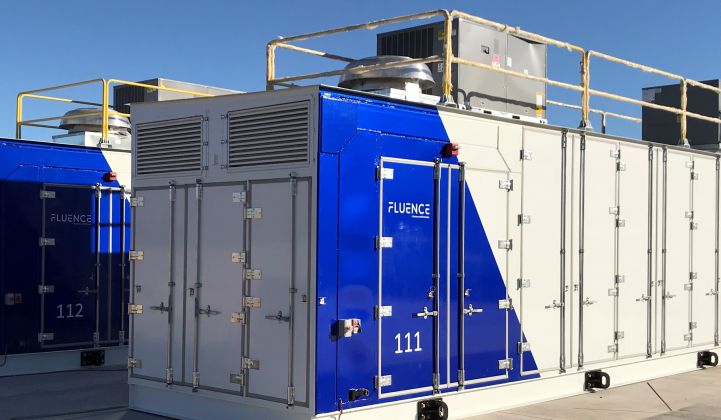Stephen Coughlin is stepping down as CEO of Fluence, the joint venture between AES and Siemens that became one of the world’s largest energy storage integrators after launching in 2018.
Coughlin led the transition into a global supplier of battery systems, during which Fluence's contracted pipeline grew from 485 megawatts to 1.7 gigawatts across 21 national markets. At the time of the launch, AES and Siemens said that they could better focus on the emerging energy storage market by spinning off their respective teams.
According to its internal count, Fluence was the leading global battery developer in 2018 and 2019, Coughlin told Greentech Media. "We’ve got an amazing growth market, and we’ve got a company that’s best positioned to win in that market."
On May 1 he will hand the reins to Manuel Perez Dubuc, with the goal of adding another 3 gigawatts of global storage capacity in 2021 and 2022. Dubuc served on the board since the year of Fluence’s founding and led AES subsidiaries in Latin America and Asia. He also became CEO of Hong Kong-based independent power producer Meiya Power Company, giving him exposure to the power markets in China and South Korea, two significant growth markets for energy storage.
The succession had been planned since late last year, Coughlin said. He will move back to AES to run the global finance operations organization, which conducts financial planning and analysis across the portfolio of energy companies that AES owns.
Big growth and the occasional setback
Fluence launched with legacy contracts from its corporate parents, most notably AES’ Alamitos project: 100 megawatts/400 megawatt-hours to serve capacity in the greater Los Angeles region. That project launched the company into what COO John Zahurancik once called “the 100 Megawatt Club,” referring to the elite cohort of companies with experience building batteries at that scale. So far, only Tesla has supplied one, at Neoen’s South Australia power plant. Alamitos is slated to commence operations next year.
An early task for Fluence, then, was to prove it could succeed independently of its well-established backers, with its own brand and sales team. The first win came just a couple of months after launch with the Ballarat project, located at a congested grid node in Victoria, Australia.
"We quickly proved we could cut the cord and do well for ourselves," Coughlin said.
Since then, the team has doubled in size and opened six offices worldwide, as its global pipeline grew expeditiously.
The company supplied the Republic of Ireland’s first large-scale battery and clinched large early deals in Australia and the United Kingdom, among other countries. In all those cases, Fluence touted a design ethos of speed and adaptability: Power markets in those countries are changing rapidly with the shift to renewables, so the batteries are designed to operate flexibly as new needs arise.
Not everything went according to plan, however. In April 2019, a Fluence battery owned by utility Arizona Public Service caught fire and a subsequent explosion injured several first responders. It was the first major grid battery failure in the U.S. in years, and the first for Fluence and AES Energy Storage. The incident showed that energy-dense lithium-ion batteries can be dangerous, even in the hands of veteran storage companies and experienced utilities.
Fluence has been working with APS to investigate what happened and why the fire started in spite of safety systems working the way they were supposed to. Preliminary analysis shows that the fire was contained to a single battery rack and that the explosion was caused by a buildup of gas in the enclosure. Industry-standard fire detection and suppression systems don’t catch or neutralize gaseous explosions.
After the fire, APS powered down two other Fluence-supplied batteries but affirmed its long-term commitment to a massive battery build-out intended to shift solar power production into more valuable evening hours. Fluence brought in outside analysts to examine its safety designs, which were found to be prudent. The company updated its control systems with additional precautions based on data from the incident.
Elsewhere, operations continued. Even as the coronavirus pandemic brought much of the global economy to a halt, Fluence has been working on 73 storage projects spanning 13 nations (power production counts as critical labor that most jurisdictions allow to happen amid social distancing orders). The company instituted remote work for office roles and new safety protocols for construction sites.
Besides executing on awarded projects, Fluence is working on its core Advancion technology platform.
"Part of maturing the company is doing everything in a way that's designed to be very cost-efficient as well as providing the ability to configure solutions for our customer," Coughlin said.
The team is also developing more virtual services to help batteries maximize their earnings potential in the markets, he added.




